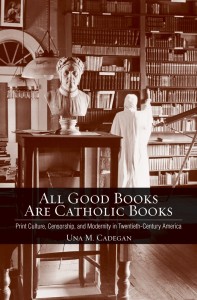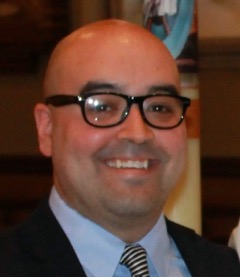Una Cadegan. All Good Books Are Catholic Books: Print Culture, Censorship, and Modernity in Twentieth-Century America (Ithaca: Cornell University Press, 2013) 230 pages.
Una Cadegan’s latest book is the eighth volume of the Cushwa Center Studies of Catholicism in Twentieth-Century America series. She seeks to define the “distinctive literary vision” of Catholic authors between the end of World War I and the Second Vatican Council (1962-1965), a period in which modernism dominated literature (2, 6). Cadegan’s analysis revolves around the struggle for contemporary Catholic authors to reconcile their faith with the American literary establishment. These authors were caught between two seemingly immovable entities: the American literary establishment, which according to leading lights like John Dewey and Walter Lippman could not admit Catholicism per se; and institutional Catholicism (60-61). Roman Catholicism, critics claimed, inherently disavowed “a robust defense of democracy and the formation of democratic citizens and a culture of democracy,” while the Holy See conflated literary modernism with a theological trend of the same name that was roundly denounced by Church authorities.
Literature allowed Catholic authors to navigate between Scylla and Charybdis. Cadegan argues that “literary history is perhaps more central to the intellectual history of twentieth-century US Catholicism than has yet been appreciated” (48). Many scholars have pointed to early twentieth-century papal decrees as proof that Catholic modernists quickly needed to go to ground; conversely, Cadegan suggests that literature, rather than theology or philosophy, created a “safe space” for Catholics to engage with modernism in a way not condemned by authorities (21; 47). In order to do so Catholic authors like Richard Sullivan and Kathleen Thompson Norris contributed to the creation of a “Catholic aesthetic,” an intellectual and theological framework against which modernist literature could be judged (21).
Cadegan’s revision of the “freeze” on theological modernism draws American Catholics back into the conversation on American intellectual history. Literature was an especially powerful weapon in the arsenal of those men and women seeking entrance into the literary establishment. As Cadegan reminds the reader throughout the book, criticism of the culture did not suggest disengagement. Far from it, in fact. While Catholic authors struggled with their own internal strictures on modernism and non-Catholic culture, their efforts to enter the literary establishment helped clarify the boundaries of the twentieth  century literary community.
century literary community.
Catholic authors were compelled to explain how they might be taken seriously when their church maintained the bogeyman-sounding Index Librorum Prohibitorum, or Index of Forbidden Books. As Cadegan notes, the Index exerted far more imaginative than practical power in the twentieth century. (88) Until the early Cold War with its increasingly voluble denunciations of Soviet authoritarianism, Catholics could cite US government-sponsored censorship as proof that limits on reading were not inherently problematic (120). While Catholics joined into anti-communist rhetoric as the Soviet Union gained in nuclear and emotive power, though, the continual existence of the Index (not formally abolished until the papacy of Paul VI) posed a substantial problem. Cadegan’s focus on the Index elucidates but one of the many nodes of anti-Catholicism among a literary élite, even present today: internationally, Booker Prize-winning author Hilary Mantel said in 2012 “the Catholic Church is not an institution for respectable people.”
Thus the struggle of American Catholics to enter the literary establishment reveals one of the paradoxes of modernism: even while the very notions of orthodoxy, tradition, and exaltation of the community were coming under fire by writers and public intellectuals, those same circles insisted on their own “orthodoxy” of excluding Catholics from the community a priori.
Cadegan’s book helps address the gap between Catholic and non-Catholic scholarship in the American academy. One of the distinctions she makes particularly well is that between theological / philosophical modernism and literary modernism. The Holy See’s robust condemnation of the former iteration has dominated Catholic historiography for decades, and that “freeze” has been reflected in a historiography of American intellectual life from which Catholics are largely absent.
Part of this is understandable due to the mid-twentieth century dearth of Catholic scholars. John Tracy Ellis argued in 1952 that Catholics lagged far behind their non-Catholic counterparts in educational attainment. By the time of his death in 1992, solutions to that problem were well underway. A 2009 study in Sociology of Religion by Neil Gross and Solon Simmons found that 15 percent of American university professors self-identified as Catholic.[i] Even now, though, at a time when the most prestigious presses publish scholarship by Catholic historians, the work is typically best received and most often cited by other Catholic historians. Cadegan’s book is poised to help change that dynamic by suggesting that Catholics are far more crucial to American intellectual history than previously considered, even if only as foils to a non-Catholic establishment.
By pursuing literary scholarship, Catholics could avoid ecclesiastical penalization otherwise faced by scholars engaged with “modernism” broadly conceived. This showed their counterparts outside the Church that they were interested in producing modern literature – even if their definition of it was highly critical of secular modernism. Thus a historiography neglectful of Catholic scholarship in other areas of academic achievement ought to consider Catholic literary in our narratives of intellectual history
Much of Cadegan’s source base comes from contemporary intra-Catholic dialogue on literature, both that produced by Catholic authors and that criticizing non-Catholic works. Letters between authors and editors, or to authors about their work, are also particularly illuminating. While some material is present, it would be good to have an even better understanding of how non-Catholics viewed Catholic attempts to attain literary respectability at the time. Cadegan’s focus on internal Catholic conversations reveals just how rich was the Catholic literary world at the time, even beyond the feared overwrought emotionalism of which Kathleen Norris was accused. Cadegan makes a convincing case for a hostile establishment, especially when her reader is a Catholic historian; but a broader audience might wonder about the conversations between non-Catholics about the excluded Romanists.
All Good Books Are Catholic Books is a landmark contribution to American and Catholic intellectual history. Until now, it appeared that the field of twentieth-century Catholic intellectual history had been well-plowed, awaiting revision by future generations. Cadegan has sidestepped that question entirely and shown that Catholic authors and their literary aspirations reveal the hidden half of twentieth century Catholic thought, breathing new life into a narrative which has long concluded that papal pronouncements restricted Catholic intellectual life to strict, neo-Thomistic repetitions of theology and philosophy. The potential for the book to reach across the divide between historians of Catholicism and those engaged in other research should not be underestimated. While it does presume some degree of knowledge about contemporary intellectual trends and even internal Catholic developments, historians without training in those fields will still be able to read All Good Books Are Catholic Books to great effect.
[i] Neil Gross and Solon Simmons, “The Religiosity of American College and University Professors,” Sociology of Religion 70:2 (2009).
Michael Skaggs is a doctoral candidate in the University of Notre Dame Department of History. His dissertation looks at Catholic-Jewish relations in twentieth-century Cincinnati, especially as they unfolded in local media. Disclaimer: Skaggs’s dissertation chair is the current director of the Cushwa Center.


0